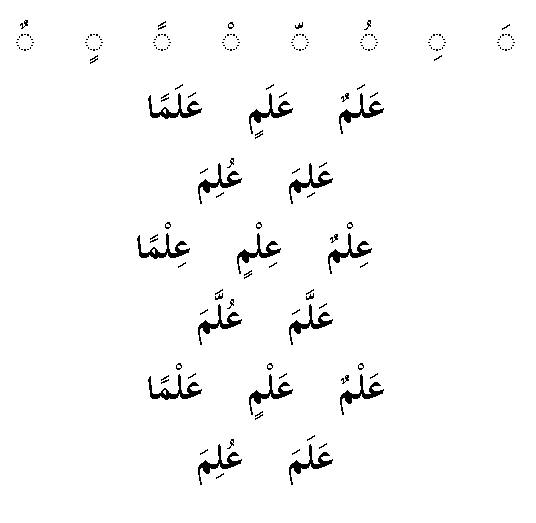Arabic Diacritics: Important But Neglected Posted by Ibnulyemen اِبْنُ اليَمَن on Mar 15, 2017 in Arabic Language, Pronunciation
Generally, diacritics are marks that are added to letters and have pronunciation- and/or meaning-related values as well as grammatical values. In Arabic, diacritical marks are:
- the fatHah َ , a semi-flat hyphen-like added on top of the letter,
- the kasrah ِ , similar to fatHah, but put below the letter,
- the Dhammah ُ, a mark somewhat like the letter wow و in Arabic, placed on top of the letter,
- the shaddah ّ, a mark like the letter seen سـ when it occurs word-initially, and
- the sukoon ْ , a mark similar to, and smaller in shape than, the letter ‘o’ in English, added on top of the letter (see figure 2).
The first three marks represent the vowels system in Arabic. The three vowels /a/, /i/, and /o/ are represented by fatHah, kasrah, and Dhammah, respectively. Meanwhile, the shaddah represent a geminated letter, i.e. a sequence of two similar sounds. The sukoon indicates that the letter on which it is placed has no vowel. Thus, albeit simple, Arabic diacritics have significant values at the sound level, meaning level, and grammar level.

As for pronunciation, a letter within the Arabic word can have four different pronunciations. For example, if you take the letterب /b/, it is pronounced as /ba/, with a fatHah بَ , as /bi/, with a kasrah بِ , as /bu/, with a Dhammah بُ, or as /b/, with a sukoon بْ . These changes in articulation significantly alter the meaning and the grammatical values of words. If you look at Figure 1 above, it is the same word but with 15 different variants, especially in pronunciation. To explain, let’s look at the first five words. The first three words have a single meaning, i.e. flag, with three different grammatical values (this will be elaborated upon in another post). The second two words are typographically the same but grammatically different. That is, they are verbs, active and passive, respectively. Similar account applies to other words in the list. Thus, as a learner of Arabic, it is essential that you properly learn these marks from the beginning. Some may say that they are not used in Modern Standard Arabic. This is true; however, native speakers of Arabic know them intuitively from the context. As you learn more and more of the language they will become a common place and you will acquire the ability of guessing the meaning of the intended variant from the context.
Now try reading these words paying attention to the pronunciation values diacritical marks:

Similar to the word in Figure 1, the word سمع has 7 different variants. Using a dictionary of Arabic, try writing them down with full assignment of the diacritical marks.
To sum up, in learning a new language, we first need to learn to articulate its sounds as intelligibly as possible (and letters for purpose of reading and writing) to be able to read words, phrases, sentences, and subsequently produce comprehensible speech in that language, speech through which our ideas are communicated effectively, i.e. without communication breakdown. In some languages, sounds to letters correspondence is pretty straightforward. However, this is not the case in Arabic when we consider diacritics. A letter in a word can have four or five different articulations depending upon the diacritical mark that goes with it. Therefore, it is essential that Arabic diacritical marks be learnt and comprehended well from the very inception of your learning.

Build vocabulary, practice pronunciation, and more with Transparent Language Online. Available anytime, anywhere, on any device.





Comments:
Ruhoof Nozeer:
Thanks for your informative lesson.
Please keep giving useful Arabic tips and how to be able to speak Arabic.
JazaakAllah Khair
Salaam
Abdur Ruhoof
ibn al-Yemen:
@Ruhoof Nozeer Sure! You will certainly see more of this. I am covering the basics at the moment. More conversational and interactive stuff that is aimed at making people like you to be more able to speak Arabic is coming soon. Stay tuned!